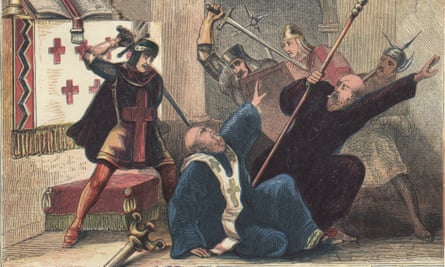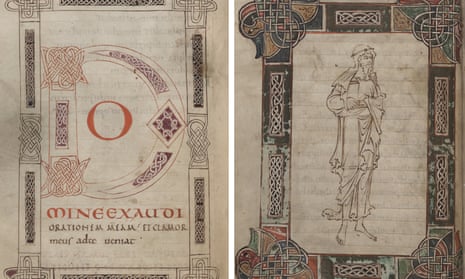On Christmas Day 1170, Thomas Becket delivered a sermon to a packed chapter house at Canterbury. His theme was the death of one his predecessors as archbishop, St Alphege, hacked to death by the Danes in the early 11th century – the only martyr in the role so far. “There will soon be another,” Becket declared. Four days later, a quartet of knights arrived drunk, on a perceived mission from the king, and dashed the archbishop’s brains across the cathedral floor. It is easy to see how, knowing his time was up, Becket might identify with Alphege. In The Book in the Cathedral, however, Christopher de Hamel argues that the two had something more tangible in common: an elaborately jewelled psalter – a book of psalms – once owned by Alphege and later treasured by Becket.
The cult that sprang up around Becket after his death spread widely and swiftly. Within three years he was Saint Thomas, and Canterbury would become one of the most visited pilgrimage sites in Europe. When the Reformation came, however, Becket fell out of favour, his relics – bones, clothes, a soiled handkerchief – destroyed as the baggage of an old form of superstition. One curious quirk of relic veneration is that books rarely make the cut. Becket’s library then, shelved unassumingly in a passageway in the cathedral, was spared the reformers’ zeal. Instead it was cherrypicked by Matthew Parker, archbishop to Elizabeth I, who in turn left his own library to his former college at Cambridge.

This is where De Hamel’s intervention begins. In the Parker Library at Corpus Christi college is a psalter dating from the late Anglo-Saxon period. On the final page, a 16th-century inscription – deemed spurious by previous scholars – links the book to two archbishops: Becket and “N”. The Book in the Cathedral is an exercise in bibliographic detective work, identifying “N” and overturning the judgment of earlier cataloguers. De Hamel – author of the wonderful Meetings With Remarkable Manuscripts – shows us all the tools of the bibliographer’s trade: dating handwriting, identifying pigments, noting the rust marks left by nails from a now-lost ornate binding. This is done with a lightness that belies De Hamel’s pre-eminence as a manuscript scholar – the telling is brisk, with a light foxing of anecdote, even as the evidence is rigorously lined up.
Hearing of the knights’ arrival, Becket attended to the stagecraft of his martyrdom, collecting his cloak, his surplice, his ring of office, before going to meet his assailants. Whether his treasured psalter, a material connection to Alphege, was among this symbolic paraphernalia is unknowable now, but De Hamel offers it as a tantalising possibility. This year marks the 850th anniversary of Becket’s murder. The identification – or rehabilitation – of his psalter, the book he carried with him into exile, possibly held at his death, is a timely and enjoyable tribute.
